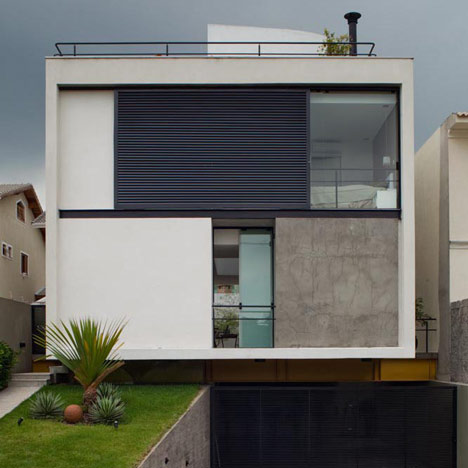This house in São Paulo by Brazilian architect Flavio Castro consists of a cubic volume perched on two yellew beams that straddle the garage below.
Called Mirante do Horto House, the two-storey residence feratures sliding panels across the front facade and a roof garden.
Photographs are by Nelson Kon.
Here's some more information from Castro:
MIRANTE DO HORTO HOUSE
_ MEMORIAL
The design of the residence came from a basic premise: maximum use of land for a huge program.
Thus, the strategy was to locate specific areas and vertical circulation In a way that the rest of spaces enjoy extreme flexibility and a Wide visual range, profiting the structure and volume.
_Divided by 3
The space created inside, in fact, is what remains after adding three small "boxes".
Dialectic interdependence between home theater, kitchen and stairway is established in the residence and demarcates a territory.
_A shadow
The service, adjacent to the garage, is four feet below street level.
Above is the container with the other functions of the house.
A shadow separates them.
The shadow on the outer part translates into light in the inner space.
The range allows the lighting and ventilation of the environments below and gives an extreme light visual to the massive upper volume.
The structure is the protagonist in the conception. Accesses through this gap were distributed as independent elements of the geometry of the house.
_Container on bars
A container rests on two “bars” and stands out in access and uses of their immediate surroundings.
The prismatic volume contains the program of the residence on two floors plus a roof garden.
The container openings are extremely flexible in the front and back facades, while quite tenuous on the side walls.
This is a consequence of the immediate surroundings because the common practice of the neighbors is constructing on the border of their private grounds.
Because of this, the program is located in the perimeter side providing a more flexible interior space and visual communication in height.
This transition provided by two metal beams allows the floor of the garage to spread to the maximum boundary of the site.
Maximum occupancy without affecting ventilation and lighting guaranteed exactly by that range.
_Vertical connection
Connecting the house from top to bottom, the right wall next to the staircase inside the house offers vertical connections to the exchange of fluids between the four height levels, while providing space for a different event in each.
On the garage floor, superior and top terrace, it generates the studio, office and support respectively, while in the main floor a large aquarium turns that wall in a prism.
_Drilled plans
The house was designed by a succession of free horizontal slabs with strategic holes.
In these 8x11 meters plans, these holes allow vertical circulation and the entry of zenith light. Natural light enters next to the water tank, passes through the upper floor and reach the social floor.
_Roof garden
Besides being a viewpoint to the city, the roof garden contributes to the sustainability of the residence because it helps cooling the area immediately below, the dorms.
Sculptural elements emerge from this observation platform disrupting the order.
The smooth curve and mass volume of the water tank and the pointed triangle that covers the access contrasts in chromaticism and formality.
Some questions:
1.There is any particular challenge in the project?
Yes. Making the most of the mixed structure (metallic and concrete) and accommodate extensive program of uses in a small ground. The conexion between metal and concrete was carefully designed because each one Answers differently to the structural demand.
2.Why did you chose these finishing materials?
The values of the materials such as chromaticism, texture and transparency were carefully chosen depending On the intentions pursued in each area. While transparency integrates, concrete abstains.
3.What attracts you most in this house?
Two huge projections directed to the front and back facades emphasize the architectural main idea which is to support a concrete cube in two metal beams. Understanding this as the basic architectural idea for this project, we note a gap between the basement and the cube. Besides supporting the main volume of the house with visual lightness, this gap brings the light and ventilation to the basement.
Credits:
Location: Mirante do Horto Condominium - Horto Florestal - São Paulo – SP - Brazil
Architect: Flavio Castro
Construction: Flavio Castro, José Claudio Magalhaes
Foundation: pile excavated type
Structure: Reinforced concrete
Slabs: massive
Walls: masonry
Hot water: solar panels
Closings: aluminum and glass
Project: 2009
Construction: 2010
Land area: 226m2
Built area: 300m2
Photos: Nelson Kon
See also:
.
| Casa 205 by H Arquitectes |
Metal Shutter Houses by Shigeru Ban | More architecture stories |

